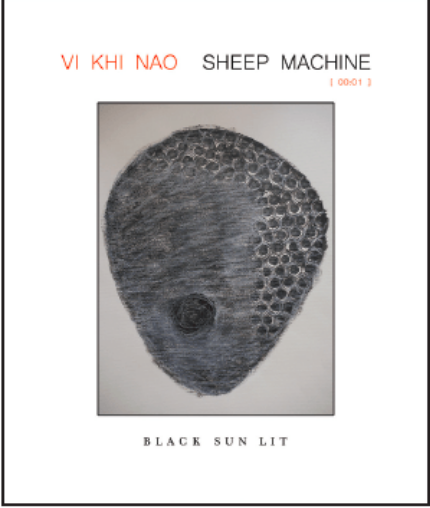
00:43
It’s difficult to measure the active frequency of images that shift only slightly. An exercise in slow, long looking, Sheep Machine: an ekphrasis logs the minutiae of a work from Leslie Thornton’s Binocular series of the same name. The original video work consists of two circular images:
On the right, a digitally manipulated, throbbing kaleidoscope,
on the left, documentary footage of sheep grazing in the Swiss Alps.
Behind the sheep, cable cars ascend and descend a mountain.
It is this enduring tranquility, kinetic and fecund, that Vi Khi Nao transcribes to paper. Fixating the entirety of her attention on three minutes of moving image, she assesses its visual impact and allows her poet’s gaze interpret its effect, tracking the artwork’s incremental development as well as how it comes to occupy her consciousness.
This particular ekphrasis, then, is not only a description of an artwork, but a document of a prolonged perceptive act and the offshoot tendrils it incites.
00:01
This is “The Pearl of the Alps.”
This is a tower with steel cables.
This is outer space with steel & cables.
This is wheat & grass.’
00:04
We know Thornton’s creation is part earth, part environs. We know appearance isn’t deceiving. We know mountains can become medium-sized primates and generally mischievous.
In this way, the text recreates the artwork’s atmospheric conditions: the viewer-reader spends time with this incremental, ongoing image and begins to reconsider the relationship between her body and her environment, how she discerns her surroundings. This relationship stratifies in unsuspecting ways, with the initially sedate scene proving rich in violence. The immovable consistency of the sheep fuses with the mechanic repetition of the cable cars to deny the onlooker even the possibility of distraction, and an asphyxiating horror pervades Khi Nao’s frame-by-frame analysis:
00:43
Here the low plants appear to take after a monster. A bucolic monster with a dark, potentially edible mouth. One of the cable wires bifurcates the face of the monster into halves. Perhaps this forebodes the Arcadian terror to come.
00:53
More and more we get the sense that the sheep want to share flesh with grass…
00:55
My eyes must testify and somehow there is a terrifying sense that something in the cinematic land-scape has been tampered, unofficially staged…
The content disallows anything but the most slow-paced progression, and within these tight confines Khi Nao’s gaze ricochets and bounces. In short, by plumbing the depths of a work in which nothing happens, she interrogates what happens inside the act of looking itself:
00:35
One eye split at the center for the pleasure and endurance of another eye.
Though the language is frequently luscious, even baroque, the text never deviates from its tight remit of transcription, objective observation and tempered extrapolation. It is this relentless and determined quality to the prose that sees its assertions feel generated, induced from somewhere deep inside the act of apprehending.
We understand these moments are climatic; Khi Nao has orchestrated conditions under which they cannot help but occur:
00:36
One moment, the sheep is serene as a lake; the next, an interior neurological disorder, ward- robing the massive mechanics and fixing the incandescent body of five luminous points.
![]()
In conversation with David Naimon, Khi Nao observes, “In order to exist you don’t have to be a human anymore. You can be a system of reality that observes, collects, stashes away.” It is, perhaps, this ability to evoke a self-aware and self-sustaining perception that has led to discussion of post-humanism in relation to her work. After the initial decision to write through three minutes of the video, her authorial agency is neutralised, and the ensuing repetition and unwavering consistency counteracts what we consider a governing consciousness. Though the language is frequently luscious, even baroque, the text never deviates from its tight remit of transcription, and the material strikes us as too regulated, the calibre of observation too focused, to be human.
Thornton’s original work is concerned with the representation of vision as implicit in the construction of reality, and Khi Nao’s exphrasis asks us to linger, as one might linger in a testing, physical pose, inside the perceptive act itself. Here, we query what is figment or fathom, what is ‘created by the malfunction of shadow or malfunction of perception?’ Is perception an inescapable filter, rather than an objective lens? A constituent part of reality, rather than its sensory portal?
While the visceral, destabilised quality of the text suggests something diametric between the human gaze and this ilk of looking, such questions are entirely hominid. Toward the end of the book, Khi Nao asks ‘What is the purpose of a human’s existence? If not to be breathing on earth, our souls de-skinned, de-wooled for ontological certainties? Do we not see this de-skinning, de-wooling, in art, poetry, films, technical advancements?’
Sheep Machine is an exercise in this process of de-wooling, a durational work that performs what it describes: an attempt at sustained attention that sees us turn into the texture of attention itself. It is inside this fabric, its weave and contours, that we must spend time in order to say something ‘certain’ about being, about our relationship to the things around us.
It is at once difficult and tedious, poetic and revelatory.
Buy the book:
SHEEP MACHINE by Vi Khi Nao. June 27, 2018. $16.00. Black Sun Lit.







